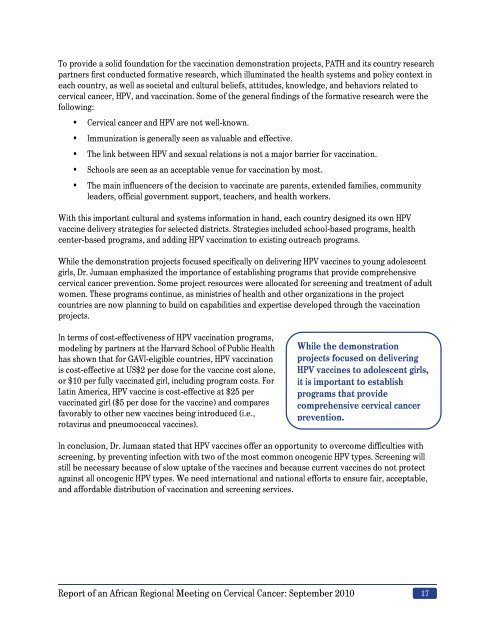Download file, English (1 MB PDF) - RHO
Download file, English (1 MB PDF) - RHO
Download file, English (1 MB PDF) - RHO
Create successful ePaper yourself
Turn your PDF publications into a flip-book with our unique Google optimized e-Paper software.
To provide a solid foundation for the vaccination demonstration projects, PATH and its country research<br />
partners first conducted formative research, which illuminated the health systems and policy context in<br />
each country, as well as societal and cultural beliefs, attitudes, knowledge, and behaviors related to<br />
cervical cancer, HPV, and vaccination. Some of the general findings of the formative research were the<br />
following:<br />
• Cervical cancer and HPV are not well-known.<br />
• Immunization is generally seen as valuable and effective.<br />
• The link between HPV and sexual relations is not a major barrier for vaccination.<br />
• Schools are seen as an acceptable venue for vaccination by most.<br />
• The main influencers of the decision to vaccinate are parents, extended families, community<br />
leaders, official government support, teachers, and health workers.<br />
With this important cultural and systems information in hand, each country designed its own HPV<br />
vaccine delivery strategies for selected districts. Strategies included school-based programs, health<br />
center-based programs, and adding HPV vaccination to existing outreach programs.<br />
While the demonstration projects focused specifically on delivering HPV vaccines to young adolescent<br />
girls, Dr. Jumaan emphasized the importance of establishing programs that provide comprehensive<br />
cervical cancer prevention. Some project resources were allocated for screening and treatment of adult<br />
women. These programs continue, as ministries of health and other organizations in the project<br />
countries are now planning to build on capabilities and expertise developed through the vaccination<br />
projects.<br />
In terms of cost-effectiveness of HPV vaccination programs,<br />
modeling by partners at the Harvard School of Public Health<br />
has shown that for GAVI-eligible countries, HPV vaccination<br />
is cost-effective at US$2 per dose for the vaccine cost alone,<br />
or $10 per fully vaccinated girl, including program costs. For<br />
Latin America, HPV vaccine is cost-effective at $25 per<br />
vaccinated girl ($5 per dose for the vaccine) and compares<br />
favorably to other new vaccines being introduced (i.e.,<br />
rotavirus and pneumococcal vaccines).<br />
While the demonstration<br />
projects focused on delivering<br />
HPV vaccines to adolescent girls,<br />
it is important to establish<br />
programs that provide<br />
comprehensive cervical cancer<br />
prevention.<br />
In conclusion, Dr. Jumaan stated that HPV vaccines offer an opportunity to overcome difficulties with<br />
screening, by preventing infection with two of the most common oncogenic HPV types. Screening will<br />
still be necessary because of slow uptake of the vaccines and because current vaccines do not protect<br />
against all oncogenic HPV types. We need international and national efforts to ensure fair, acceptable,<br />
and affordable distribution of vaccination and screening services.<br />
Report of an African Regional Meeting on Cervical Cancer: September 2010 17
















